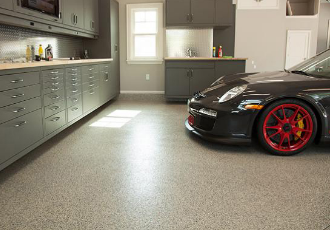Sometimes a finished slab of concrete has significant imperfections and knowing how to repair the slab is a builder or homeowner’s best choice. First, you must start by determining the scope of the problem. There are several things that can go wrong with a concrete floor that can be fixed with a bit of effort. These problems can include:
- The reinforcing bar causing cracks due to being too near the surface of the slab;
- Ridges or humps left by finishers;
- The expansion of contraction cracks;
- Debris – such as chunks of wood – floating out of concrete while it’s still wet; or
- Damage caused by heavy objects dropped on the slab before it is cured.

Use a ruler to determine the length and width of the area to be repaired. This includes bumps, depressions, and ridges as well as small areas of shallow surface irregularities. Any material which comes up above the level of the floor should be chipped away with a chipping hammer or – for larger areas – an electric chipping hammer or jack hammer. Clean the area of dust and debris in order to provide a solid surface for the new materials to adhere to.
Next, mix 1 part Portland Cement (type I or II) to 2 ½ parts clean masonry sand and add latex or a polymerized liquid bonding agent to the dry mixture. Use just enough to wet the material and bring it to a stiff plastic consistency. Apply some bonding agent directly to the area to be patched, like glue, and follow the instructions on the label.
Wet the area where the patch is to be applied with clean, fresh water. Do not flood the area but make sure all surfaces are dampened. Dry surfaces will draw moisture from the cement mixture too quickly and cause shrinking or cracks in the patch. Scoop the mixture with a bull-nosed pointing trowel and place mixture into or on the patch location. Be sure to work it into the space forcefully in order to force out the air bubbles. Level the surface of the wet cement with a steel finishing trowel when the material becomes stiff by flattening and smoothing the surface. This will cause the cement paste to rise to the surface to form the surface of the finished slab.
Allow the repaired areas to set for another hour or two in order to let it get hard before you finish troweling. Splash a bit of water onto the surface to delay the drying and make the finishing process somewhat easier. Using the edge of the trowel to shave, scrape off any cement mixture that has spread to the adjacent finished surfaces and allow the concrete to finish setting.
If you prefer working with a professional backed by a warranty, reach out to Garage Living for an estimate backed by a warranty. The Garage Living proprietary process and specialized equipment is designed to overcome DIY obstacles and retail product constraints.